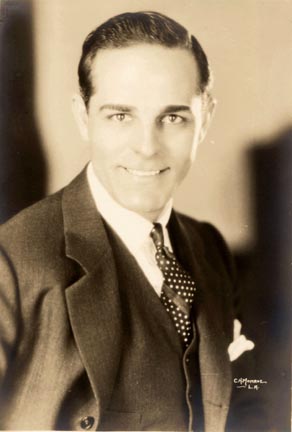Order a reprint
of this photo!
Click here for ordering instructions
 Antonio Moreno
Born Sept. 26, 1887, in Madrid, Spain. Moreno was living
in Seville in his early teens when two men who were touring Europe
took a liking to the boy. With his mother's blessings, he went
with the men on th rest of their tour and back to America. A Civil
War widow, Charlotte Morgan, paid for him to attend Williston
Seminary in Northhampton, MA. While working with a local gas and
electric company around 1910, the great stage actress Maude Adams
brought a play to town, and Moreno got a job as a walk-on. He
toured with the company and continued acting on the stage for
the next two years. In 1912, he made his first film, "The
Voice of the Million" for Rex. He then secured a job with
Biograph and worked with that company, sometimes under D.W. Griffith's
direction, until 1914 when he joined Vitagraph. He made almost
50 films for the company and became a much-sought after leading
man. He moved to Pathé in mid-1917, but disliked the serials
they placed him in. As the twenties began, he secured a contract
with Paramount through the help of his friend, the ill-fated William
Desmond Taylor. In 1923, he married socialite Daisy Canfield Danziger,
and they built one of the most fabulous homes in Hollywood. During
the decade, Moreno also worked for First National and MGM starring
with some of the biggest female stars such as Gloria Swanson ("My
American Wife" - 1922), Colleen Moore ("Look Your Best"
- 1923), Mary Miles Minter ("The Trail of the Lonesome Pine"
- 1923), Bebe Daniels ("The Exciters" - 1923), Constance
Talmadge ("Learning to Love" - 1925 and "Venus
of Venice" - 1927) and Pola Negri ("The Spanish Dancer"
- 1923). Two of his best remembered roles were in Rex Ingram's
"Mare Nostrum"
(1926) opposite the beautiful Alice Terry and in Clara Bow's "It" (1927).
Both films have survived for viewers today. Because of his Spanish
accent, Moreno's days as a leading man came to an end with the
coming of sound, although he found sufficient work doing the Spanish
versions of sound films during those early days. Although they
were separated at the time, Moreno was devastated with the loss
of his wife, Daisy, in a car accident in 1933. He continued as
a character actor making over 40 films in the 1930's, 1940's and
1950's. Moreno was a wealthy man and lived in his Beverly Hills
home quite comfortably. He suffered a stroke in 1965 and passed
away Feb. 15, 1967.
Selected films of this star available for viewing:
Judith of Bethulia (1914)
Mare Nostrum (1926)
It (1927)
Antonio Moreno
Born Sept. 26, 1887, in Madrid, Spain. Moreno was living
in Seville in his early teens when two men who were touring Europe
took a liking to the boy. With his mother's blessings, he went
with the men on th rest of their tour and back to America. A Civil
War widow, Charlotte Morgan, paid for him to attend Williston
Seminary in Northhampton, MA. While working with a local gas and
electric company around 1910, the great stage actress Maude Adams
brought a play to town, and Moreno got a job as a walk-on. He
toured with the company and continued acting on the stage for
the next two years. In 1912, he made his first film, "The
Voice of the Million" for Rex. He then secured a job with
Biograph and worked with that company, sometimes under D.W. Griffith's
direction, until 1914 when he joined Vitagraph. He made almost
50 films for the company and became a much-sought after leading
man. He moved to Pathé in mid-1917, but disliked the serials
they placed him in. As the twenties began, he secured a contract
with Paramount through the help of his friend, the ill-fated William
Desmond Taylor. In 1923, he married socialite Daisy Canfield Danziger,
and they built one of the most fabulous homes in Hollywood. During
the decade, Moreno also worked for First National and MGM starring
with some of the biggest female stars such as Gloria Swanson ("My
American Wife" - 1922), Colleen Moore ("Look Your Best"
- 1923), Mary Miles Minter ("The Trail of the Lonesome Pine"
- 1923), Bebe Daniels ("The Exciters" - 1923), Constance
Talmadge ("Learning to Love" - 1925 and "Venus
of Venice" - 1927) and Pola Negri ("The Spanish Dancer"
- 1923). Two of his best remembered roles were in Rex Ingram's
"Mare Nostrum"
(1926) opposite the beautiful Alice Terry and in Clara Bow's "It" (1927).
Both films have survived for viewers today. Because of his Spanish
accent, Moreno's days as a leading man came to an end with the
coming of sound, although he found sufficient work doing the Spanish
versions of sound films during those early days. Although they
were separated at the time, Moreno was devastated with the loss
of his wife, Daisy, in a car accident in 1933. He continued as
a character actor making over 40 films in the 1930's, 1940's and
1950's. Moreno was a wealthy man and lived in his Beverly Hills
home quite comfortably. He suffered a stroke in 1965 and passed
away Feb. 15, 1967.
Selected films of this star available for viewing:
Judith of Bethulia (1914)
Mare Nostrum (1926)
It (1927)
Return to photos page

